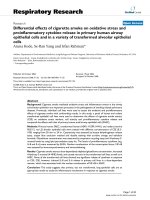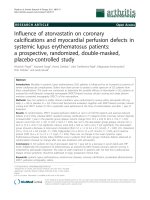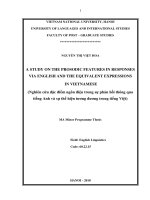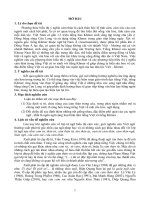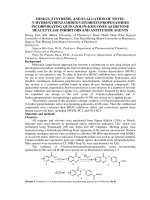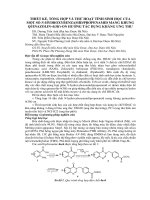A brief report on proto austroasiatic and proto vietic vocabulary in vietnamese (báo cáo tóm tắt về từ proto nam á và proto vietic trong tiếng việ
Bạn đang xem bản rút gọn của tài liệu. Xem và tải ngay bản đầy đủ của tài liệu tại đây (416.33 KB, 14 trang )
To appear in the proceedings of the HỘI THẢO QUỐC TẾ NGÔN NGỮ
HỌC LẦN THỨ IV held by the Institute of Linguistics in Hanoi 19-20
December 2020 (conference information at http://
www.vienngonnguhoc.gov.vn/bai-viet/chuong-trinh-hoi-thao-quoc-tengon-ngu-hoc-lan-thu-iv_756.aspx). The related conference
presentation in Vietnamese is at />BÁO CÁO TÓM TẮT VỀ TỪ PROTO-NAM Á VÀ PROTOVIETIC TRONG TIẾNG VIỆT
(A Brief Report on Proto-Austroasiatic and Proto-Vietic
Vocabulary in Vietnamese)
Mark Alves
1. INTRODUCTION
I have so far identified several hundred native Vietnamese words that are ProtoAustroasiatic etyma or regional Austroasiatic words (over 200 words) or Proto-Vietic
etyma (over 500 words). These words are carefully selected based on comparative data of
proto-language reconstructions and recurring phonological patterns among two dozen
Vietic lects. This is a considerable update to previous studies of native vocabulary of
Vietnamese words. These significant numbers of native vocabulary require that we change
the perceived role of Chinese loanwords in the Vietnamese vocabulary. Vietnamese is far
from a relexified language, having a sizeable quantity of significant Austroasiatic and
Vietic vocabulary. However, how best to characterize this situation requires more
consideration.
In this brief report, I (a) review the data sources and methods of analysis, (b)
discuss the findings based on semantic domains, and (c) offer some thoughts on what the
linguistic data suggests about the connection between Vietnamese and its linguistic
predecessor. A list of the 200-plus Austroasiatic items is provided at the end of the paper in
Table 2.
2. PREVIOUS STUDIES
Vietnamese was first claimed to be related to other Austroasiatic languages in the
early 1850s. Logan (1852-1855) linked it to what he called the “Mon-Annam” language
family. Lexical data supporting this linguistic affiliation very gradually increased. Maspero
(1912) provided over a dozen lists of comparative data with Vietnamese, other Vietic
languages, and Austroasiatic languages, even though he asserted Vietnamese was related to
Tai.
In the second half of the 20th century, some basic wordlists were generated to
propose possible Austroasiatic etyma in Vietnamese (e.g. Thomas and Headley 1970,
Huffman 1977, etc.). But generally, they focused on approximately 100 items of basic
vocabulary. Hồ Lê (1992) provided the longest list of possible Austroasiatic items, some
200 possible items. However, he did not deal with issues of phonological correspondences
or of broader regional comparative linguistic data, meaning that data must still be sifted.
Much of it is supported in this study, but many other items must be excluded.
In the 21st century, some 2,100 Proto-Austroasiatic items proposed by Shorto
(2006) were published and then made available online in the Mon-Khmer Etymological
Dictionary (2007). Also, 1,200 Proto-Vietic items were included in the same database, the
tentative work of Ferlus. Moreover, there are reconstructions of Proto-Tai (Li 1977 and
Pittayaporn 2009), Old and Middle Chinese (I use Baxter and Sagart’s 2014 version),
various electronic databases of Vietnamese (e.g. the SEAlang Library Vietnamese), among
other comparative resources. These allow identification of etymological sources of
Vietnamese words with more precision than ever.
3. DATA, METHODS, AND PRELINARY RESULTS
To Ferlus’s Proto-Vietic lists of a dozen Vietic language varieties, I have added
data from wordlists of a dozen more lects (Arem (Kasuga 1994), So Thavung (Premsrirat
1998, 1999), Nguon (Nguyễn P. P. 1997), Muong Bi (Nguyễn V.K. et al. 2002), Babaev
and Samarina 2018 (May), etc.). I compared this data with (a) Shorto’s Proto-Austroasiatic
lexical reconstructions, (b) proto-language reconstructions of branches of Austroasiatic in
the online Mon-Khmer Etymological Dictionary, (c) Early and Late Sino-Vietnamese
words, and (d) databases and reconstructions of neighboring language families: TibetoBurman, Austronesian, and Hmong-Mien. As I did so, I posited over 140 additional ProtoVietic etyma and some 40 Proto-Austroasiatic etyma.
I then ranked the Vietic data based on the number of Vietic sub-groups—including
Viet-Muong, Pong-Cuoi, and the remaining archaic languages—with attestations for each
posited Proto-Vietic etymon. The evidence for sub-branching of Vietic is still being
debated, so these sub-groups are only general indicators for purposes of determining
occurrences of words. Words with attestations in two or three sub-groups are considered
viable Proto-Vietic etyma. However, Proto-Austroasiatic etyma seen in one sub-group of
Vietic are also considered likely ancient lexical retentions. This criterion increases the
likelihood that the words are indeed of considerable time depth in Vietic, potentially dating
to the pre-Qin Đông Sơn era and even to the Neolithic period.
Phonological patterns of initials, vowels, finals, and tones were considered as well
as other issues of semantic shift and the still poorly understood early history of language
contact in the region. The overall phonological correspondences are too complex to present
in this report, and I have described them elsewhere (Alves 2020). In general, the patterns
are sufficient to establish connections between these Vietnamese words and variously
Austroasiatic, Vietic, Old or Middle Chinese, or Tai. In some cases, the origins of words
cannot be determined as they so widespread, but in general, when words are
reconstructable in Austroasiatic, they are treated as Austroasiatic roots of the
corresponding Vietnamese cognates.
The results so far are (a) nearly 200 Vietnamese words which are likely ProtoAustroasiatic etyma, (b) over two dozen words in Vietnamese which are cognate to words
in other Austroasiatic languages but not reconstructable to Proto-Austroasiatic, (c) over
500 Vietnamese words of strictly native Vietic origin (i.e. not in Proto-Austroasiatic or
multiple branches of Austroasiatic), and (d) about 100 Vietnamese words with Vietic
reconstructions of likely Chinese origin and several of possible Tai origin. Another 150
Proto-Vietic etyma and about two dozen Vietic words which are Proto-Austroasiatic etyma
are not attested in Vietnamese. Thus, the data reveal several hundred native Austroasiatic
and/or Vietic words in Vietnamese, the largest number identified to date with sufficient
data and methodology to increase confidence in the claims.
As I assembled the data, I also marked them for part of speech and semantic fields,
which allows for exploration of the culture and natural environment of Vietic people prior
to and soon after (i.e. widespread early Chinese loanwords) the arrival of people from
northern China. I summarize this matter in Section 4.
4. SEMANTIC DOMAINS IN THE NATIVE LEXICON OF VIETNAMESE
The primary semantic fields used in this study including those of the Max Planck
Institute’s WOLD (World Loanword Database at The semantic
domains are very broad and need additional subcategories for further exploration of
cultural aspects: this matter is for a future study. Table 1 lists the semantic domains with
numbers of words in each. The several hundred items, including both Austroasiatic and
Vietic etyma, clearly demonstrate a solid core of native vocabulary.
In Table 1, I have added a “supercategories” column to allow for convenience in
making broader generalizations. The first two supercategories of general experience (basic
actions and technology, etc.) and consumption (agricultural and vegetation, etc.) each have
some 200 items. Words related to the individual (the body, the home, and clothing and
grooming) consist of over 100 items. These hundreds of native etyma do not give the sense
of a language that is highly separated from its predecessor: this lexical data very clearly
connects Vietnamese to its Vietic and Austroasiatic origins.
As for society, the systems of Vietnamese terms for kinship and pronouns have
seen restructuring through language contact with Chinese (cf. Alves 2018). And yet, the
core 1st, 2nd, and 3rd person pronouns are native words, and both ‘grandchild’ and ‘greatgrandchild’ are Austroasiatic etyma. Nearly 20 words of emotions, cognition, and speech
and over two dozen words of sense perception are native etyma. Chinese loanwords have
certainly entered these domains (e.g. hiểu ‘to understand’, thấy ‘to see’, etc.), and yet a
core native portion still remains.
Finally, dozens of Vietnamese words of spatial relations, time, and quantity are
native etyma. Vietnamese numbers are particularly notable: from ‘1’ to ‘10’ (as well as
‘100’), all are native etyma (cf. Alves 2020 for complete discussion and lists of words).
This is in contrast with Proto-Tai, which has borrowed Chinese numbers from 2 to 99.
Whatever status the Chinese-speaking community had in the first millennium CE, the daily
social circumstances were such that native numbers were apparently used predominantly in
the likely multilingual Vietic community.
Table 1: Semantic domains of Vietic and Austroasiatic etyma
Supercategories
General experience
Consumption
The individual
Society
Sentience
Time and space
Semantic Domains
Basic actions and technology
Motion
Physical world
Agriculture and vegetation
Animals
Food and drink
Body
House
Clothing and grooming
Kinship
Social and political relations
Warfare and hunting
Possession
Emotions and values
Cognition
Speech and language
Sense perception
Quantity
Spatial relations
Time
Numbers
129
31
37
82
103
37
97
9
14
25
4
5
9
9
6
4
28
18
28
18
5. MAIN CONCLUSIONS AND FUTURE PROSPECTS
The impact of Chinese loanwords on the Vietnamese lexicon, including both
standard Sino-Vietnamese and Early Sino-Vietnamese, is unquestionably profound. Many
thousands of Chinese loanwords, especially those of the bisyllabic compounds, can be
found in Vietnamese, and in virtually all the semantic domains considered in this paper.
However, the question is to what degree these words have entered those domains and how
to characterize the resulting linguistic changes from Vietic to Vietnamese.
While some Chinese words for body parts have been borrowed (e.g. gan ‘liver’, tim
‘heart’, etc.), the noticeably high number of native words in this domain (nearly 100,
including body parts as well as body functions and sensations) highlights the native
elements of the Vietnamese lexicon. Beyond basic categories of numbers, body parts, and
natural phenomena all made up of native etyma, there is a core Proto-Vietic vocabulary of
agricultural production, warfare and hunting, parts of the home, clothing and grooming,
and basic concepts of trade. In addition, while the Vietnamese syllable structure has gone
from a more Austroasiatic type to a more Sinosphere type, like those of Chinese, Tai, and
Hmong-Mien, Proto-Vietic consonants and vowels are readily found in Vietnamese. As for
etymological origins of syllables, in preliminary exploration (in collaboration with James
Kirby) of the inventory of syllables in Vietnamese, less than 25 percent of the 3,000-plus
syllables (not including tones) consist of monosyllabic morphs of Chinese origin, with
some percentage of homophonous native morphs. Thus, despite the many thousands of
Chinese loanwords, over 75 percent of the inventory of Vietnamese monosyllable morphs
are native in origin. Thus, we can suggest that Vietnamese is a Vietic language at its core,
but with surrounding transformative effects of contact with Chinese.
However, challenges arise in trying to understand developments of the period at the
time of Chinese arrival. Archaeological studies of northern Vietnam show material culture
that is not widely supported in tribal Vietic groups, whose sociocultural circumstances are,
of course, distinct, but which is lexically represented in Vietnamese (e.g. thạp ‘situla’, sáo
‘flute’, vạc/ thố ‘cauldron’, đèn ‘lamp’, etc.). Also, original terms for items that, according
to archaeological data, long preceded the arrival of the Chinese are today nevertheless of
Chinese origin, such as those related to metallurgy (e.g. đồng ‘bronze’, dao ‘dagger/large
knife’, tên ‘arrow’, etc.).
As for the several hundred native words that date potentially to Proto-Vietic or
early Vietic prior to major language contact with Chinese, analysis of their semantic
domains—combined with information from archaeological and historical data—can
provide some tentative ethnolinguistic hypotheses about early Vietic culture at the time of
Han Dynasty expansion into modern-day northern Vietnam. Also, comparing the several
hundred Vietnamese words of Austroasiatic and Vietic origin with the several hundred
items of early Chinese loanwords should allow new hypotheses about sociocultural
changes in pre-recorded history of early Vietic and Sinitic contact. These are research
topics that I am pursuing and will share as results are available. However, ideally, interdisciplinary teams will take on such tasks to produce the most reliable results. Research
done in a mono-disciplinary vacuum is more likely to lead to incorrect assumptions about
human history in the Red River Delta.
Note: Readers are welcome to contact me via the internet to obtain the full database with
all Austroasiatic, Vietic, Chinese and Tai words and additional information. The database
is a work in progress and will undoubtedly change and hopefully expand over time.
REFERENCES
Alves, Mark J. 2016. Identifying Early Sino-Vietnamese Vocabulary via Linguistic,
Historical, Archaeological, and Ethnological Data, in Bulletin of Chinese Linguistics 9
(2016):264-295. />Alves, Mark J. 2017. Etymological research on Vietnamese with databases and other
resources. Ngôn Ngữ Học Việt Nam, 30 Năm Đổi Mới và Phát Triển (Kỷ Yếu Hội Thảo
Khoa Học Quốc Tế), 183-211. Hà Nội: Nhà Xuất Bản Khoa Học Xã Hội.
Alves, Mark J. 2018. Chinese Loanwords in Vietnamese Pronouns and Terms of Address
and Reference, in Proceedings of the 29th North American Conference on Chinese
Linguistics (NACCL-29), 2017, Volume 1, ed. by Marjorie K.M. Chan and Hana Kang,
286-303. Columbus, Ohio: The Ohio State University.
/>nd_Terms_of_Address_and_Reference_ToA_R_.
Alves, Mark J. 2020. Historical Ethnolinguistic Notes on Proto-Austroasiatic and ProtoVietic Vocabulary in Vietnamese. Journal of the Southeast Asian Linguistics Society
13.2: xiii-xlv. />Babaev, Kirill V. and Irina V. Samarina. 2018. May language: Materials of the RussianVietnamese linguistic expedition (in Russian). YASK Publishing House.
Baxter, William H. and Laurent Sagart. 2014. Baxter-Sagart Old Chinese reconstruction,
version 1.1 (20 September 2014).
/>Blust, Robert and Stephen Trussel. 2010. Austronesian Comparative Dictionary. Web.
Last accessed: 15 August 2020.
Hà, Văn Tấn. 2018. The Making of Việt Nam. Thế Giới Publishers.
Hồ, Lê. 1992. Từ Nam Á trong tiếng Việt [Austroasiatic words in Vietnamese]. in Tiếng
Việt và Các Ngôn Ngữ Dân Tộc Phía Nam, 65-110. Hà Nội: Nhà Xuất Bản Khoa Học
Xã Hội.
Huffman, Franklin E. 1977. An Examination of Lexical Correspondences Between
Vietnamese and Some Other Austroasiatic Languages. Lingua 43.2:171-98.
Kasuga, Atsushi. 1994. A Study on Arem Phonology. Master’s thesis. Tokyo University.
Logan, J. R. 1852-1855. Ethnology of the Indo-Pacific islands. The Journal of the Indian
Archipaelago and Eastern Asia VI (1852), VII (1853), VIII (1854), IX (1855).
Maspero, Henri. 1912. Etude sur la phonétique historique de la langue Annamite: Les
Initiales. Bulletin de l’École Franỗaise dExtrờme-Orient 1-127.
Mon-Khmer Etymological Dictionary. SEAlang Mon-Khmer languages project.
Last accessed 20 August 2020.
Munda Etymological Dictionary. SEAlang Mon-Khmer languages project.
Last accessed 20 August 2020.
Nguyễn, Phú Phong. 1997. Le parler Nguồn: Language d’un minorité ethnique des hautes
vallées du Sông Gianh Quảng Bình, Việt Nam. Université Paris 7, Denis Diderot.
Nguyễn, Văn Khang, Bùi Chi, and Hoàng Văn Hành. 2002. Từ điển Mường-Việt (A
Mường-Vietnamese dictionary). Hà Nội: Nhà Xuất Bản Văn Hoá Dân Tộc.
Shorto, Harry L. 2006. A Mon-Khmer Comparative Dictionary. Paul Sidwell, Doug
Cooper, and Christian Bauer eds. Canberra: Pacific Linguistics.
The Sino-Tibetan Etymological Dictionary and Thesaurus. The University of California,
Berkeley. Last accessed: 15 August
2020.
Suwilai, Premsrirat. 1998. So (Thavung)-English-Thai Glossary, Part I. The Mon-Khmer
Studies Journal 28:189-218.
Suwilai, Premsrirat. 1999. So (Thavung)-English-Thai Glossary, Part II. The Mon-Khmer
Studies Journal 29:107-132.
Thomas, David D. and Robert K., Jr. Headley. 1970. More on Mon-Khmer Subgroupings.
Lingua 25:398-418.
SEAlang Library Vietnamese. Last
accessed: 20 August 2020.
Table 2: Austroasiatic etyma in Vietnamese (# indicates tentative reconstructions I
have proposed based on available linguistic data)
Semantic
Fields
agr.
Vietnamese
English Gloss
Austroas
iatic
#Cduŋ
Proto-Vietic
nong
agr.
agr.
agr.
agr.
agr.
agr.
agr.
agr.
mói (梅)
si
vừng
mít
tranh / gianh
sồi
buồng
bí
agr.
agr.
agr.
cành
cau
cây
basket for winnowing/flat
basket
a thing used when transplanting
banyan
sesame
jackfruit/breadfruit
thatch-grass
mango
bunch (of bananas)
squash/pumpkin/waxgourd
(Bennicasa cerifera)
branch
arecanut
tree
#C-mɔːl
#ɟri
#lŋaː
#mi:t
#plang
#svaaj
*buuŋ
*cpiir
*c-mɔːlʔ
*ɟ-riː
*vɨŋ
#mi:t
*p-lɛɲ
NR
*bɔːŋ
*k-biːrʔ / k-piːrʔ
*t-kɛːŋʔ / gɛːŋ
*kaw
*gəl / kəl
betel leaf
press (fruit)/wring (v)
fruit
*kaŋ
*kaw
*kəl ‘to
cut
down/fell
trees’
*k-raːŋʔ
*lngal,
*ŋgal
‘plough’
*ml[əw]
*pit
*pləjʔ
agr.
agr.
sàng
cày
winnow (n)
plough (v)/a plough (n)
agr.
agr.
agr.
trầu / giầu
vắt
trái
agr.
agr.
bông
rễ
flower/blossom
root
*pnpuŋ
*ris
agr.
agr.
agr.
agr.
gạo
cám
lá
măng
rice, husked
bran
leaf
bamboo shoots, edible
*rk[aw]ʔ
*skaamʔ
*slaʔ
*t1ɓaŋ
*ɗoːŋʔ
*g-raːŋ
*gal
*b-luː
*pat
*p-leːʔ > pleːʔ /
tleːʔ
*poːŋ
*k-riɛs / k-rɛs |
res
*r-koːʔ
*t-kaːmʔ
*s-laːʔ
*t-ɓaŋ
Semantic
Fields
agr.
agr.
agr.
agr.
agr.
agr.
animals
animals
animals
animals
Vietnamese
English Gloss
chuối
sọ
bưởi
riềng
mía
săng
cơng
sủa
rắn
rận
banana
taro
pomelo
galangal (Alpinia galanga)
sugarcane
wood/plant
peacock
bark (v)
snake
louse on the body
animals
animals
animals
animals
animals
rái
[rắn] mối
chó
cầy
gấu
otter
lizard
dog
dog
bear (n)
animals
animals
animals
animals
animals
animals
animals
animals
animals
animals
chim
cúi (heo cúi)
sừng
mỏ
cánh
cá
khái
mọt
con sấu
trâu
bird
pig
horn of animals
beak
wing
fish
tiger
termite/weevil
crocodile/alligator
buffalo
animals
animals
animals
animals
animals
animals
animals
animals
animals
animals
cục tác
vượn
ác
rệp ‘bedbug’
muỗi
cú
sóc
ruồi
tơm
trăn
cackle (v)
gibbon
crow
centipede
mosquito/fly
owl
squirrel
fly (n)
crayfish/shrimp
python
animals
ve vẩy ‘to
wag’
bè
mục ‘rotten,
rot’
cạo ‘to
scrape/scratch/
shave’, ( nạo )
basic
act./tech.
basic
act./tech.
basic
act./tech.
Proto-Vietic
shake/wag (the tail) (v)
Austroas
iatic
*t1luuj[ ]
*t2rawʔ
NA
NA
NA
NA
#k-voːŋ
#-roh/rɔh
*[b]saɲʔ
*[d]mrəɲ
ʔ
*bheʔ
*ɓulʔ
*cɔʔ
*cgəj
*c-guːʔ /
c-kuːʔ
*-ciːm
*cur
*d2raŋ
*ɟɓuəh
*kaiɲʔ
*kaʔ
*klaʔ
*kmuət
*krɓə[ə]ʔ
*krpiiw,
*krpuʔ
*ktaat
*kwaaɲʔ
*kʔaak
*kʔip
*muujs
*ŋk[awʔ]
*prɔɔk
*ruj
*sum
*t1lan,
*t1laan
*was
raft (n)
#bɛ:
#bɛ:
rotten/moldy
#ɓuk
#ɓuk
scratch/scrape
#ka:w
#ka:wʔ
*caːjʔ
*s-roːʔ
*paːs
*b-riɛŋ
*k-mɛːʔ
*s-raŋ
*k-voːŋ
*k-rɔh
*p-səɲʔ
*m-rəɲʔ
*p-seːʔ
*ɓoːlʔ
*ʔa-cɔːʔ
#gəj
*c-guːʔ / c-kuːʔ
*-ciːm
*guːrʔ | kuːrʔ
*k-rəŋ
*k-ɓɔh
*kɛːŋʔ
*ʔa-kaːʔ
*k-haːlʔ > kʰaːlʔ
*k-mɔːc
*k-ruːʔ
*c-luː
*k-taːk
*k-vaɲ
*kr-?aːk
*kr-siːp
*mɔːs (final *-l?)
*kuːʔ
*p-rɔːk > kʰlɔːk
*m-rɔːj
*soːm
*k-lən
*vasvas
Semantic
Fields
basic
act./tech.
basic
act./tech.
basic
act./tech.
basic
act./tech.
basic
act./tech.
basic
act./tech.
basic
act./tech.
Vietnamese
English Gloss
nhắp
basic
act./tech.
basic
act./tech.
basic
act./tech.
basic
act./tech.
basic
act./tech.
basic
act./tech.
basic
act./tech.
basic
act./tech.
basic
act./tech.
basic
act./tech.
basic
act./tech.
basic
act./tech.
basic
act./tech.
basic
act./tech.
basic
act./tech.
basic
act./tech.
basic
act./tech.
Proto-Vietic
close (eyes, mouth) (v)
Austroas
iatic
#k-ɲVp
tát
bail out/drain water (v)
#ksaːc
*ʔa-saːc
rút
gather/pull out w. hands (v)
#p-ruuc
*p-ruːc
vòng
‘circle/round’
liếm
round/circle
#wV:ŋ
#βɔŋ
lick (v)
*[c]limʔ
*-lɛːmʔ
gãy
break/break off/snap (v)
*[d]kah
#gas
vác
carry (on shoulder) (v)
*ɓaːk
múc
draw water (v)
*ɓɔʔ
(tentative
#bak)
*ɓək
méo
misshapen/malformed
#ɓiəwʔ
nổ
burst/explode (intr.) (v)
*ɓiəwʔ
‘aslant’
*bt1uh
đập
dam/dike
#təp
gõ
knock/rap (v)
*dəp ‘to
dam’
*g[uə]h
cắt
cut (v)
*kat
*kac
lấy / lậy
take (v)
*liʔ
*leːʔ / -leːʔ
ngồi
sit/sit down (v)
*ŋguj
*ŋuːj
vả ‘to slap’;
vỗ ‘to
clap/slap/flap’
bóc
slap (v)
*pah ‘to
slap’ ; #mpo:h
*pɔɔk
#tVmpa:h
bửa
split/cleave (wood) (v)
chát
sour/bitter/acrid
*puh
*bah | pah
(tentative
#paah in
Vietic,
Bahnaric,
Vietic)
*sraat
#ca:t
đâm ‘to
stab/pierce’
dập
beat/punch/pierce (v)
*t1əm
*təm
bury/cover (v)
*t1əp
#dVp
vẫy
wave (v)
*was
#wVs
vứt ‘to throw
away’ / vất
vặn
throw (v)
*wat
*-vət
twist/wring (v)
*wiɲ
*vaɲʔ
peel (tr.) (v)
*k-ɲap > kʰɲap
*ɓuːk
*ɗoh
#gɔ:h
#pɔ:k
Semantic
Fields
basic
act./tech.
Vietnamese
English Gloss
Proto-Vietic
tooth/fang/canine/tusk
stick/pull out tongue (v)
knee
forehead
belly/stomach
Austroas
iatic
NA (cf.
Bahnaric
*pat,
Katuic
*tampat,
Khmuic
*bi:t)
NA (cf.
Bru
patɯ̤ŋ)
NA (cf.
Katuic
*duom)
NA (cf.
Katuic
*tʄoh)
NA (cf.
WestBahnaric
*snap)
#Cnaɲ
#lVl
*[ ]kuul
*[k]liəŋ
*buuŋʔ
tắt
put out (a fire) (v)
basic
act./tech.
dựng
build (v)
basic
act./tech.
đùm
wrap (v)
basic
act./tech.
nhỏ
drip (v)
basic
act./tech.
nắp
cover/blanket/lid
body
body
body
body
body
body
body
nanh
lè
gối
trán
bụng ( cf lao
*buŋỈ
xác
xương
body
bone
*cak
*cʔaaŋ
cằm
chân
mật
gãi
chết
cổ
khạc
địt
nách
ngứa
mắt
miệng
mũi
vai
sống
ruột
tay
chin
leg/foot
gall
scratch (due to itch) (v)
die (v)
neck/throat
spit (v)/spittle
fart/pass gas (v)
armpit
itch/be itchy (v)
eye
mouth
nose
shoulder
back/ridge
intestines
arm/hand
lá lách
răng
tóc
spleen
tooth
hair on the head/feather
*dgam
*ɟəŋ
*k.mət
*kais
*kc[ə]t
*kɔʔ
*khaak
*kt1iit
*kʔik
*lŋaaʔ
*mat
*miəɲʔ
*muh
*paʔ
*ruŋʔ
*ruuc
*sii[ʔ];
*t1iiʔ
*slaʔ
*sraŋ
*suk
*cak
*tʃ-ʔaːŋ > ɟaːŋ /
tʃɨəŋ
#gam
*ɟiːŋ | ciɲ
*məc
*-kaːs
*k-ceːt
*koh
*kr-haːk
#ti:t
*-nɛːk
#ŋa:ʔ
*mat
*mɛːŋʔ
*muːs
*ɓaːj
*k-roːŋʔ
*rɔːc
*siː
body
body
body
body
body
body
body
body
body
body
body
body
body
body
body
body
body
body
body
body
*p-sət / p-sat
*pr-təŋʔ > pdəŋʔ ?
*duːm
*k-̨ʄɔh
*s-nəp (< s-rnəp)
*k-nɛːŋ
*t-lɛːl
*t-kuːlʔ
*k-laːɲʔ
*buŋʔ
*laːʔ ~ laː
*k-saŋ
*-suk
Semantic
Fields
body
Vietnamese
English Gloss
ngáp
yawn (v)
body
móng
nail/hoof/claw
body
vú
breast
body
iả
feces/defecate
body
body
óc
giết
brain
kill (v)
body
điếc
deaf
body
ngửi
‘smell/sniff’
breathe (v)
body
đốt
joint/internode
body
khoanh
cross (arms, legs) (v)
body
má
cheek
body
ngực
chest
body
sinh đẻ
give birth/lay/be born (v)
clothing/gro
oming
nón
hat, conical
Austroas
iatic
*sʔaap
*t1m[uə]
ŋʔ
*ʔbuuʔ
*ʔic
“excreme
nt” (cf.
Katuic
*ʔɛh)
*ʔuək
*kcet
NA (cf.
Bahnaric
*tik ~
*təc)
NA (cf.
Katuic
(Pacoh
tər.ŋɯh
and Kui
ŋɤh)
NA (cf.
Katuic
*toot,
*ʔatoot)
NA (cf.
Monic
*khwi̱ an
‘to curl
up’,
Khmer
kvien
‘curled
up’; etc.)
NA (cf.
Palaungi
c
*cmaaʔ)
NA (cf.
Palaungi
c *nuk)
NA
(NOTE:
Only
Vietic
and
Bahnaric
*dɛh)
*ɗuən
Proto-Vietic
*sŋ-?aːp > s-ŋaːp
/ -ʔaːp
*-mɔːŋʔ
*b-rn-uːʔ / kbuːʔ
*ʔɛh
*c-?ɔːk
*k-ə-ceːt (< k-pceːt ?)
*dɛːk | tɛːk
*t-ŋəs
*tuːc
*k-vɛːŋ
*-maːʔ
*ŋək
*tɛh
*ɗɔːnʔ
Semantic
Fields
clothing/gro
oming
cognition
emotions/va
lues
food and
drink
food and
drink
Vietnamese
English Gloss
Austroas
iatic
*taaɲ
Proto-Vietic
đan
weave (v)
bao
hôn
dream (n)
kiss (v)
*mp[ɔ]ʔ
*ɟhuuɲ
‘to sniff’
*[ ]ŋuuc
*s-poː
*huːɲ
nhậu
drink (v) (of alcohol)
muối
salt
*ɓɔːjʔ
ripe/cooked
*ɓɔɔh
‘salt’; cf.
Katuic
*ɓɔɔj
‘salt’
*ciinʔ
food and
drink
food and
drink
food and
drink
food and
drink
chín
cối
mortar (for rice)
*guul
*t-koːlʔ
vơi
lime, mineral
*knpur
*k-puːr
chày
pestle
*tʃ-reː
food and
drink
food and
drink
food and
drink
function
words
kinship
kinship
kinship
kinship
kinship
kinship
thịt
meat/flesh
*nrəjʔ,
*nrəəj[ ],
*rnəjʔ
*sac
nướng
roast (on embers) (v)
*t1aŋ
*ɗaːŋʔ
bú
suckle/suck at breast (v)
*ʔbuuʔ
nay
this
hắn
chắt
cháu
con
mẹ
mày
he/she/3s
great grandchild
grandchild
child/person
mother > female
you/2s
kinship
kinship
kinship
nó
bay
em
he/she/3s
you (plural)/2p
younger sibling
motion
motion
sá
chảy
way/path
flow/run (v)
motion
motion
motion
motion
chạy
đứng
lội
bay
run (v)
stand up/get up (v)
swim/wade/float
fly (v)
*niʔ;
*nih
*[ʔ]anʔ
*ceʔ
*cuuʔ
*kuun
*meeʔ
*mi[i]ʔ;
*miih
*nVʔ
*pɛj
NA (cf.
Katuic
*ʔaʔɛɛm
“younger
sibling”)
#kra:ʔ
*cuur,
*cuər,
*car[s]
*ɟarʔ
*ɟəŋ
*lujʔ
*par
*b-ʔuːʔ > PPC
ʔuːʔ / buːʔ
*-niː
*taːɲ
*ɲuːʔ
*ciːnʔ (< c-ʔiːnʔ)
*-siːt
*hanʔ
*cat
*cuːʔ
*kɔːn
*meːʔ ~ mɛːʔ
*miː
#na:ʔ
#baj
*ʔɛːm
*k-raːʔ > kʰlaːʔ
*cas
*ɟalʔ
*təŋʔ
#lo:jʔ
*pər
Semantic
Fields
motion
Vietnamese
English Gloss
Proto-Vietic
cloud
Austroas
iatic
NA (cf.
Katuic
*ɗol)
#Cmil
nổi
float on water (v)
physical
world
physical
world
physical
world
physical
world
physical
world
physical
world
physical
world
physical
world
physical
world
physical
world
mây
củi
fire/firewood
*[ ]ʔus
rú
forest
*briiʔ
*guːs | kuːs (final
*-l?)
*m-ruːʔ
nước
water
*ɗaak
*ɗaːk
sấm
thunder
*grəm[ʔ]
*k-rəmʔ
gió
wind
*kjaal
*k-jɔːʔ > kʰjɔːʔ
sáng
shine (moon)/be bright (v)
*p-laːŋʔ
vỏ
bark/shell (n)
*plaaŋʔ
‘to shine’
*pus
sông
river
*ruŋ
*k-roːŋ
rừng
forest
*k-rəŋ
possession
possession
possession
mất
vay
mượn
lose (v)
borrow (v)
borrow (v)
quantity
two
quantity
quantity
quantity
hai (cf. vài ‘a
few’)
chín
một
ba
NA (cf.
Katuic
*kruuŋ
‘forest’;
*krɨŋ,
*crɨŋ
‘virgin
forest’)
#bit
*pəl/*pul
*smaaɲ
‘to ask’
*ɓaar
*ciːnʔ
*moːc
*paː
quantity
sensory
sensory
sensory
sensory
sensory
bốn
nhẹ
ấm
thơm
chua ‘sour’
cứng
four
light (in weight)
warm/lukewarm
fragrant
bitter/sour
hard/solid
sensory
sensory
sensory
đắng
ngọt
mắng
bitter
sweet
hear/listen (v)
*dciin[ʔ]
*muuj
*piʔ (or
#pee)
*punʔ
*[s]ɟaal
*[s]ʔəm
*dhum
*ɟuʔ
*kr[ɔ]ŋ;
also,
Katuic
*kəŋ;
*kt2aŋ
*lŋuut
*rməŋ
nine
one
three
*ɗoːs (final *-l?)
*k-məl
*-pɔh
*ɓət
#βal
*maːɲʔ
*haːr
*poːnʔ
*-ɲɛːlʔ
*s-ʔəmʔ
*tʰəːm
*coːʔ
*kəŋʔ
*taŋʔ
*t-ŋɔːc
*c-maŋʔ
Semantic
Fields
sensory
Vietnamese
English Gloss
nặng
heavy
social/politi
cal
người
human/people
social/politi
cal
quê
village
spatial
spatial
spatial
spatial
ngái
đăm (archaic)
thấp
sấp
far
right side
short/low
face down (lying)
spatial
spatial
ngiêng
nít ‘small (of
children’), ít
‘few’
trong
inclined to/on the side of
small
dưới
năm
sắp
mới
ngày
hết
chài
căm ‘spokes’
(dialect)
bắn
spatial
spatial
time
time
time
time
time
warfare/hun
ting
warfare/hun
ting
warfare/hun
ting
Austroas
iatic
NA (cf.
Katuic
*ʔntəŋ,
*ʔntaŋ)
NA (cf.
Bahnaric
*bŋaːj)
NA (cf.
Katuic
*wiil,
*weel)
#cŋaaj
#Ctam
#tVVp
*gruup,
*[p]kup
*ɟkii[ŋ]
*kɗit
Proto-Vietic
*k-lɔːŋ
under
year
about to/prepared to
new
day
finished
net, casting
*kluuŋ
‘belly/mi
ddle’
*kt1aal
*cn1am
*srap
*tmiʔ
*tŋiiʔ
*ʔət
#ɟaːl
arrow/arrowhead
*kam
*kam
shoot (v)
*paɲʔ
*pəɲʔ
inside
*-naŋʔ
*ŋaːj
*k-veːr
*s-ŋaːjʔ
*dam / tam
#tVp
*k-rəp
*s-gɛːŋ
*ɗiːt (cf. ?it
‘few’)
*-taːlʔ
*c-n-əm < cəm
#srap
*ɓəːjʔ
*-ŋiː
*heːt
*ɟaːl


